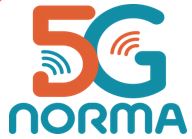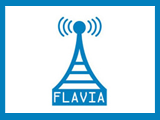5G-Aura is an Innovative Training Network (ITN) of the Marie Skłodowska-Curie Actions (MSCA), which aims to support the career development and training of young researchers through international and inter-sector mobility.
The vision of future 5G networks encompasses a heterogeneous communication landscape in which existing Radio Access Technologies (RATs) will be integrated with evolving wireless technologies and systems, software-design network architectures and cloud-enabled services.
The ambition towards 5G systems is to provide customized user-centric services at an affordable price, in an effort to strengthen key societal needs in heterogeneous domains such as transportation, health, environment, etc.
We expect that the emerging 5G ecosystem will consist of ultra-dense, heterogeneous deployments of multiple RATs with a wide range of backhauling options (microwave, E-band, optical, etc.), owned and shared by multiple stakeholders and supporting highly diverse applications and services, from Over-The-Top (OTT) applications, to proximity services and Machine Type Communications (MTC).
Effectively harnessing the potential of all these innovative and heterogeneous features and providing a programmable multi-tenant network architectural framework will be the key to the success of 5G, and it will be the main objective of 5G-Aura.
5G NORMA
July 2015 - December 2017

5G NORMA aims to develop a novel mobile network architecture that provides the necessary adaptability in a resource efficient way able to handle fluctuations in traffic demand resulting from heterogeneous and dynamically changing service portfolios and to changing local context. The developed “multi-service and context-aware adaptation of network functions” will allow for a resource-efficient support of these varying scenarios and help to increase energy-efficiency by always selecting the most energy efficient option.
The “mobile network multi-tenancy” approach to be developed by 5G NORMA will leverage the adaptability and efficiency of network functions and enable an inherent and dynamic sharing and distribution of network resources between operators. This will allow operators to increase their revenue through the new services, while leveraging the efficiency of the architecture to do so in a cost-effective way.
5G NORMA will apply concepts from software-defined networking (SDN) and network virtualization (NFV), and, in the long-term, will result in enhanced and flexible 5G base stations, software-based centralized controllers and software-based RAN elements.
5G NORMA work is substantiated by the leading players in the mobile communications ecosystem and aim to underpin Europe’s leadership position in this global design effort.
GreenTouch
June 2010 - May 2015

GreenTouch is a consortium of leading Information and Communications Technology (ICT) industry, academic and non-governmental research experts dedicated to fundamentally transforming communications and data networks, including the Internet, and significantly reducing the carbon footprint of ICT devices, platforms and networks. The GreenTouch consortium concluded in 2015. This is an archival site.
By 2015, our goal is to deliver the architecture, specifications and technologies – and demonstrate key components – needed to increase network energy efficiency by a factor of 1000 compared to 2010 levels. We'll accomplish this by designing fundamentally new network architectures and creating the enabling technologies on which they are based.
In reaching this goal, GreenTouch members and the global community will benefit from: i) A reinvention of today’s telecommunications networks, ii) A sustainable future for data networking and the Internet, iii) Unprecedented collaboration with leading experts from around the world, iv) Participation in fundamental research in exciting new areas, v) Access to network models and studies examining key energy related issues, vi) New information on network power consumption, traffic growth, and energy trends.
FP7 CROWD
January 2013 - June 2015

CROWD promotes a paradigm shift in the future Internet architecture towards global network cooperation, dynamic network functionality configuration and fine, on demand, capacity tuning. The project targets very dense heterogeneous wireless access networks and integrated wireless-wired backhaul networks. In this framework, CROWD pursues four key goals: i) bringing density-proportional capacity where it is needed, ii) optimising MAC mechanisms operating in very dense deployments by explicitly accounting for density as a resource rather than as an impediment, iii) enabling traffic- proportional energy consumption, and iv) guaranteeing mobile user’s quality of experience by designing smarter connectivity management solutions.
FP7 FLAVIA
July 2010 - June 2013

Wireless networks importance for the Future Internet is raising at a fast pace as mobile devices increasingly become its entry point. However, today's wireless networks are unable to rapidly adapt to evolving contexts and service needs due to their rigid architectural design. We believe that the wireless Internet’s inability to keep up with innovation directly stems from its reliance on the traditional layer-based Internet abstraction. Especially, the Link Layer interface appears way too abstracted from the actual wireless access and coordination needs. FLAVIA fosters a paradigm shift towards the Future Wireless Internet: from pre-designed link services to programmable link processors. The key concept is to expose flexible programmable interfaces enabling service customization and performance optimization through software-based exploitation of low-level operations and control primitives, e.g., transmission timing, frame customization and processing, spectrum and channel management, power control, etc. FLAVIA’s approach is based on three main pillars: i) lower the interface between hardware-dependent layers and upper layers, ii) apply a hierarchical decomposition of the MAC/PHY layer functionalities, and iii) open programmable interfaces at different abstraction levels. To prove the viability of this new architectural vision, FLAVIA will prototype its concept on two wireless technologies currently available, 802.11 and 802.16, representing today’s two main radio resource allocation philosophies: contention-based and scheduled. Moreover, FLAVIA will assess the applicability of the proposed architecture concepts to the emerging 3GPP standards. FLAVIA’s concept will allow boosting innovation and reducing the cost of network upgrades. Operators, manufacturers, network designers, emerging third-party solution developers, and even spontaneous end users, will be able to easily and rapidly optimize and upgrade the wireless network operation, quickly prototype and test their new protocols, and adapt the wireless access operation to emerging scenarios or service needs.
Research Activities

Organizing Committee and Guest Editorials
- Track Chair of IEEE WCNC 2024 Track on Emerging Technologies, Network Architectures, and Applications
- Track Chair of IEEE ICC 2023 SAC on RIS
- Guest Editor of IEEE Access SI on RIS
- Editor of IEEE Transactions on Wireless Communications
- Guest Editor of IEEE Communications Magazine FT on RIS
- Associate Editor of IEEE Vehicular Technology Magazine
- Area Editor of Elsevier Computer Networks Journal
- Organizer of iFIRE ACM Workshop, co-located with ACM MobiHoc 2019
- Track chair of “Edge computing and transport in 5G”, in IEEE CSCN 2018
- Guest Editor of “Context-Based Resource Management and Orchestration in 5G Wireless Access Networks” issue, in Wireless Communications and Mobile Computing 2018, Hindawi
- Track chair of “Softwarization and Network slicing”, in IEEE CSCN 2017
Technical Program Committees
- IEEE ICC 2020
- ACM CONEXT 2019
- IEEE GLOBECOM 2019
- IEEE PIMRC 2019
- IEEE SECON 2019
- EuCnC 2018
- IEEE WCNC 2018
- ICNC CQSM 2018
- IEEE GLOBECOM 2018
Reviewer
- IEEE/ACM Transaction on Networking
- IEEE Transaction on Wireless Communications
- IEEE Transaction on Mobile Computing
- IEEE/ACM Journal on Selected Area Communication
- IEEE Communications Letters
- IEEE Communications Magazine
- IEEE Internet of Things Journal
- Elsevier Computer Communications
- Elsevier Computer Networks
- IEEE INFOCOM
- IEEE WoWMoM

Teaching
Courses
Mobile Radio Systems [2023-2024]
Laboratorio di Reti [2023-2024]
Mobile Radio Systems [2022-2023]
Mobile Radio Systems [2021-2022]
Fondamenti di reti e telecomunicazione [2014-2015]
Reti di Comunicazione e Internet [2014-2015]
Internet e Reti di Telecomunicazioni [2013-2014]
Thesis
- Francesca Roveda (Master degree thesis) – Politecnico di Milano (Italy) – 2020
- Antonio Albanese (Master degree thesis) – Politecnico di Milano (Italy) – 2018
- Lanfranco Zanzi (Master degree thesis) – Politecnico di Milano (Italy) – 2017
- Denny Tremolada (Master degree thesis) – Politecnico di Milano (Italy) – 2015
- Stelios Moschos (Bachelor degree thesis) – Alexander Technological Educational Institute of THEssaloniki (ATEITHE in Greece) – 2013
Contact
Tel. +49 (0) 6221 4342 232
Fax. +49 (0) 6221 4342 115
E-Mail: 

Inquiry
Elements
Text
This is bold and this is strong. This is italic and this is emphasized.
This is superscript text and this is subscript text.
This is underlined and this is code: for (;;) { ... }. Finally, this is a link.
Heading Level 2
Heading Level 3
Heading Level 4
Heading Level 5
Heading Level 6
Blockquote
Fringilla nisl. Donec accumsan interdum nisi, quis tincidunt felis sagittis eget tempus euismod. Vestibulum ante ipsum primis in faucibus vestibulum. Blandit adipiscing eu felis iaculis volutpat ac adipiscing accumsan faucibus. Vestibulum ante ipsum primis in faucibus lorem ipsum dolor sit amet nullam adipiscing eu felis.
Preformatted
i = 0;
while (!deck.isInOrder()) {
print 'Iteration ' + i;
deck.shuffle();
i++;
}
print 'It took ' + i + ' iterations to sort the deck.';
Lists
Unordered
- Dolor pulvinar etiam.
- Sagittis adipiscing.
- Felis enim feugiat.
Alternate
- Dolor pulvinar etiam.
- Sagittis adipiscing.
- Felis enim feugiat.
Ordered
- Dolor pulvinar etiam.
- Etiam vel felis viverra.
- Felis enim feugiat.
- Dolor pulvinar etiam.
- Etiam vel felis lorem.
- Felis enim et feugiat.
Icons
Actions
Table
Default
| Name |
Description |
Price |
| Item One |
Ante turpis integer aliquet porttitor. |
29.99 |
| Item Two |
Vis ac commodo adipiscing arcu aliquet. |
19.99 |
| Item Three |
Morbi faucibus arcu accumsan lorem. |
29.99 |
| Item Four |
Vitae integer tempus condimentum. |
19.99 |
| Item Five |
Ante turpis integer aliquet porttitor. |
29.99 |
|
100.00 |
Alternate
| Name |
Description |
Price |
| Item One |
Ante turpis integer aliquet porttitor. |
29.99 |
| Item Two |
Vis ac commodo adipiscing arcu aliquet. |
19.99 |
| Item Three |
Morbi faucibus arcu accumsan lorem. |
29.99 |
| Item Four |
Vitae integer tempus condimentum. |
19.99 |
| Item Five |
Ante turpis integer aliquet porttitor. |
29.99 |
|
100.00 |











